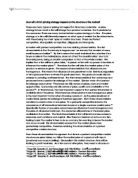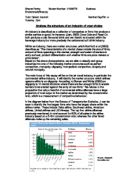From these characteristics it is apparent that firms in a perfect competition market structure are price takers, i.e. follow the market price of a product with inputs (purchase) and outputs (selling). Generally in this market structure, firms will be looking to profit maximise. As a firm cannot alter price, they need to choose an output level where Marginal Revenue = Marginal Cost as this is where a firm can profit maximise.
Secondly I will discuss the pricing strategies of firms in a monopoly market structure. A monopoly can be defined as “a large, single supplier that dominates an industry”. The reason for a monopoly having one single seller is due to high barriers of entry or government or legal protection. An example of a barrier of entry is economies of scale. Whereby a firm benefits from having a lower cost per unit due to the size of production, with a potential new firm not benefiting from economies of scale, it would be hard to enter this market. Therefore a monopoly has no direct competition so is free to set its own prices. However it still must seek to profit maximise, unless it is a state owned monopoly, so needs to find a level of output which would satisfy this. Especially as a monopoly still faces a downward sloping demand curve so still needs to be aware of charging an unfairly high price for a good or service. A monopolist may choose to limit the quantity sold so to increase prices artificially. Another option may be to sell where Marginal Revenue = Marginal Cost, just like all other firms. As monopolies benefit from lower costs due to the scale of production etc. They will make a larger profit than firms in other markets. An example of a monopolist making profit is abnormal profit is below.
Figure 1 - Profit for a monopolist
A monopsony is a market which has a single buyer and many sellers. The price is determined by how much the single buyer is willing to pay for the good or service, as otherwise no transactions in the market would occur as the sellers don’t have any other buyers to sell to. Therefore the sellers have to accommodate towards the buyers needs. In essence the buyer in a monopsony has a monopoly in buying power and the seller trades under perfect competition. This therefore shows you that firms are price takers in a monopsony.
An oligopoly is a market where a few firms dominate the market. An example of this market structure is the Supermarket industry. Each firm produces a similar product; nevertheless each product is differentiated from one another between firms. Therefore the main type of competition in an oligopoly is in terms of marketing i.e. how well each firm can market their products to differentiate it from the market. An important aspect of an oligopoly is that each firm is interdependent upon each other. By this I mean that each firm is affected by another firm’s actions. However each firm still has enough power in the market to be a price maker, thus meaning that each firm has its own demand curve, yet each firm is greatly affected by one another. One example of this is if one firm lowers their price, other firms will follow so not to lose market share. This is shown in the kinked demand curve below.
From this graph you can see that if a firm were to lower its price, rivals would do the same. Therefore this results in only a little increase in quantity sold. Also the price level would be lower as well. If this were to happen, the overall industry profit would fall. Thus it is in the best interest of firms to sell where profit is maximised. This leads me to collusion. Collusion is where firms actively collude together so to maximise industry profits. Firms may use tactics such as fixing prices or setting quotas. An example of a collusive oligopoly is a cartel. A cartel is a formal collusive agreement between firms. In this sense by the firms working together, they create a monopoly so benefit from being the only seller, such as being able to set their own prices. However cartels and collusion its self is illegal. Nevertheless non-collusion does occur. “Game theory is a theory of rational behaviour in interactive decision-making problems”. Game theory shows that even without a formal agreement between firms, a form of non-collusion may occur. This can be where firms follow each other prices, otherwise known as tacit collusion “Where oligopolists take care not to engage in price cutting, excessive advertising or other forms of competition. There may be unwritten ‘rules’ of collusive behaviour, such as price leadership”. Price leadership is where firms in the market follow the price of the market leader. In essence this could suggest that firms in an oligopoly are often price takers but have the ability to be price makers.
Not all firms look to make a profit. For instance charities are firms that are set up so to provide a benefit to people who need help, not to gain profit for private benefit. Also government owned firms do not seek to gain profits, instead to just provide a product or service that provides a benefit to the public. In these situations the market structure that these firms will be in, will not affect the pricing strategy of the firms. This is due to the firm’s aims, not being profit driven so will not look to profit maximise and instead will just look to cover their costs, so will set a price that will enable this. The price level, for this, would be set at Marginal Revenue = Marginal Cost = Average Cost.
All firms must have Marginal Revenue = Marginal Cost for it to maximise its profits. This is because either side of this the firm would for MR > MC, be under utilising and therefore be able to increase output and produce profit, and for MR < MC the firm would be over outputting and would not be making the maximum profit compared to its inputs. This is the same for all firms; in all market structures so the actual type of market a firm is in, may not greatly affect the pricing strategy of a firm, as in reality theories often do not occur.
Bibliography
Besanko, D. And Braeutigam, R,R. Third Edition. Microeconomics.
Cleaver, T. 2007. Understanding the World Economy. Routledge.
Lipsey. R,G. And Chystal. K, A. 2004. Economics. Oxford University Press
Sloman, J. 2007. Essentials of Economics. Pearson Education
Page 306. Besanko, D. And Braeutigam, R,R. Third Edition. Microeconomics.
Page 28. . Sloman, J. 2007. Essentials of Economics. Pearson Education
Page 114. Sloman, J. 2007. Essentials of Economics. Pearson Education
Page 307. Besanko, D. And Braeutigam, R,R. Third Edition. Microeconomics.
Page 29. Cleaver, T. 2007. Understanding the World Economy. Routledge.
Page 204. Lipsey. R,G. And Chystal. K, A. 2004. Economics. Oxford University Press







